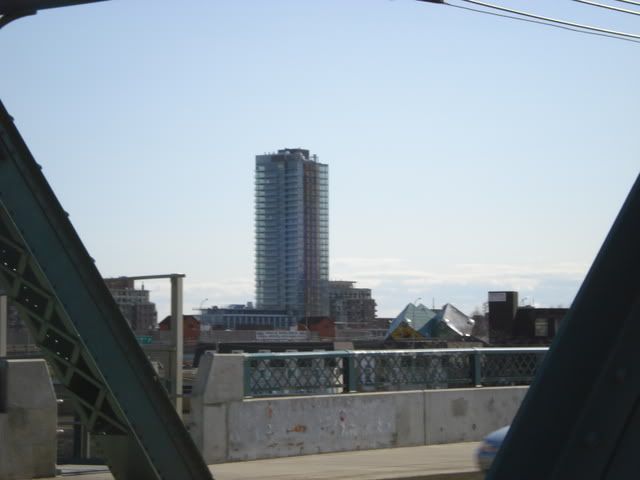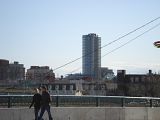yyzer
Senior Member
DEVELOPMENT
John Bentley Mays
A place to visit, a place to live
JOHN BENTLEY MAYS
From Friday's Globe and Mail
E-mail
April 11, 2008 at 12:00 AM EDT
Back in 2001, when a group of private developers bought the abandoned Gooderham and Worts distillery on Toronto's lower east side, it was an open question whether this collection of 45 ruggedly handsome Victorian structures could be made profitable enough to keep it standing.
The factory complex lay on the edge of a nowhere-land of doomed or demolished warehouse and terminal buildings east of Parliament Street. Even more forcefully than the rest of downtown Toronto, it was sealed off from the waterfront by a high railway embankment.
Many observers thought that the cluster — one of North America's best-preserved examples of 19th-century industrial architecture — was destined to be swept away, or left to rot quietly in place.
But seven years after the purchase, the wonderful old distillery is still there, and, to judge from appearances, is very much a going concern. The developers have wooed art galleries, restaurants, a theatre and other tenants to move into the old tank houses and fermenting plants, and engineered other motives, such as festivals, for visitors to stroll the factory's laneways. And in their most significant move, they have invited city folk to take up residence in this spot back of the beyond, pulling it ever closer to the pulse of ordinary urban life.
The beat goes on: In late May, homeowners will start moving into Pure Spirit, the Distillery District's first condominium tower completed by the current consortium of developers.
Another residential tall building, called Clear Spirit, is 75 per cent sold out. And the Gooderham, the third and final condo block, goes on the market in May.
When this trio of graceful modernist towers is built out — the creator of all three is the prominent Toronto tall-building firm architectsAlliance —more than 1,000 new units will be added to the city's housing stock, with very little damage done to the Victorian fabric of the factory.
This flurry of positive real estate news struck me as a good reason to pay a visit to David Jackson, a member of the team of investors who saved the place, at his office in the heart of the district.
"The idea at the beginning was to clear the centre for arts, culture and entertainment," Mr. Jackson told me. "It was a great heritage site in the middle of nowhere. So what do we do to make this happen?
"We thought that arts was the keystone. But if you're going to bring in the arts, you have to have somewhere for people to eat, and you have to make this a place people can come to for more than half an hour, where they will want to stay. We could see the buildings were fantastic, but what we needed to do was knit it all together. Part of all that had to be a residential community, to make this a phenomenal place to live and work, as well as shop and experience the restaurants and patios."
Long-time readers of this column know that I have not been wholly happy with the results.
So far, and despite its engaging old architecture, the Distillery District has the unfortunate atmosphere of a suburban shopping mall or theme park — something not yet really part of the city. Mr. Jackson doesn't take much issue with this view.
"We are not fully there yet. The next phase is going to be important, and, on a go-forward basis, I think the site will mature. The retailers and galleries will change. And I think it's going to become a great place to live."
As Mr. Jackson and his partners know, providing a place to live (in addition to being an interesting place to visit) is the key to the district's future viability and success. The consortium has welcomed the work of the public corporation Waterfront Toronto, which is currently supervising the residential development of the district's immediate neighbourhood, called the West Donlands, and the lakefront territory south of the railway berm and the Gardiner Expressway. And while there are no plans to open the distillery site to car traffic, a new TTC route on Cherry Street, one of the boundaries of the district, will ease access, and further encourage the population of the area.
"It's difficult not being an island, when you have 80 acres of wasteland around you," Mr. Jackson said. "But we're going to be a nucleus of a bunch of new developments. And there will be connections. We have worked with the West Donlands precinct plan, to see how we can connect a new pedestrian route into our south courtyard, which we are now creating.
"Waterfront Toronto is also talking about the possibility of pushing Trinity Street [the main north-south pedestrian artery in the Distillery District] under the berm to the community and parklands south of here.
"We want to be part of the community. But the enclave character of this place won't change, inasmuch as it is a historic precinct. You'll always feel that you are in a different part of the city, very different from anything else. And it will stay that way."
Next week: I talk with architectsAlliance's Peter Clewes, the architect driving the design of the Distillery Historic District towers.
John Bentley Mays
A place to visit, a place to live
JOHN BENTLEY MAYS
From Friday's Globe and Mail
April 11, 2008 at 12:00 AM EDT
Back in 2001, when a group of private developers bought the abandoned Gooderham and Worts distillery on Toronto's lower east side, it was an open question whether this collection of 45 ruggedly handsome Victorian structures could be made profitable enough to keep it standing.
The factory complex lay on the edge of a nowhere-land of doomed or demolished warehouse and terminal buildings east of Parliament Street. Even more forcefully than the rest of downtown Toronto, it was sealed off from the waterfront by a high railway embankment.
Many observers thought that the cluster — one of North America's best-preserved examples of 19th-century industrial architecture — was destined to be swept away, or left to rot quietly in place.
But seven years after the purchase, the wonderful old distillery is still there, and, to judge from appearances, is very much a going concern. The developers have wooed art galleries, restaurants, a theatre and other tenants to move into the old tank houses and fermenting plants, and engineered other motives, such as festivals, for visitors to stroll the factory's laneways. And in their most significant move, they have invited city folk to take up residence in this spot back of the beyond, pulling it ever closer to the pulse of ordinary urban life.
The beat goes on: In late May, homeowners will start moving into Pure Spirit, the Distillery District's first condominium tower completed by the current consortium of developers.
Another residential tall building, called Clear Spirit, is 75 per cent sold out. And the Gooderham, the third and final condo block, goes on the market in May.
When this trio of graceful modernist towers is built out — the creator of all three is the prominent Toronto tall-building firm architectsAlliance —more than 1,000 new units will be added to the city's housing stock, with very little damage done to the Victorian fabric of the factory.
This flurry of positive real estate news struck me as a good reason to pay a visit to David Jackson, a member of the team of investors who saved the place, at his office in the heart of the district.
"The idea at the beginning was to clear the centre for arts, culture and entertainment," Mr. Jackson told me. "It was a great heritage site in the middle of nowhere. So what do we do to make this happen?
"We thought that arts was the keystone. But if you're going to bring in the arts, you have to have somewhere for people to eat, and you have to make this a place people can come to for more than half an hour, where they will want to stay. We could see the buildings were fantastic, but what we needed to do was knit it all together. Part of all that had to be a residential community, to make this a phenomenal place to live and work, as well as shop and experience the restaurants and patios."
Long-time readers of this column know that I have not been wholly happy with the results.
So far, and despite its engaging old architecture, the Distillery District has the unfortunate atmosphere of a suburban shopping mall or theme park — something not yet really part of the city. Mr. Jackson doesn't take much issue with this view.
"We are not fully there yet. The next phase is going to be important, and, on a go-forward basis, I think the site will mature. The retailers and galleries will change. And I think it's going to become a great place to live."
As Mr. Jackson and his partners know, providing a place to live (in addition to being an interesting place to visit) is the key to the district's future viability and success. The consortium has welcomed the work of the public corporation Waterfront Toronto, which is currently supervising the residential development of the district's immediate neighbourhood, called the West Donlands, and the lakefront territory south of the railway berm and the Gardiner Expressway. And while there are no plans to open the distillery site to car traffic, a new TTC route on Cherry Street, one of the boundaries of the district, will ease access, and further encourage the population of the area.
"It's difficult not being an island, when you have 80 acres of wasteland around you," Mr. Jackson said. "But we're going to be a nucleus of a bunch of new developments. And there will be connections. We have worked with the West Donlands precinct plan, to see how we can connect a new pedestrian route into our south courtyard, which we are now creating.
"Waterfront Toronto is also talking about the possibility of pushing Trinity Street [the main north-south pedestrian artery in the Distillery District] under the berm to the community and parklands south of here.
"We want to be part of the community. But the enclave character of this place won't change, inasmuch as it is a historic precinct. You'll always feel that you are in a different part of the city, very different from anything else. And it will stay that way."
Next week: I talk with architectsAlliance's Peter Clewes, the architect driving the design of the Distillery Historic District towers.


